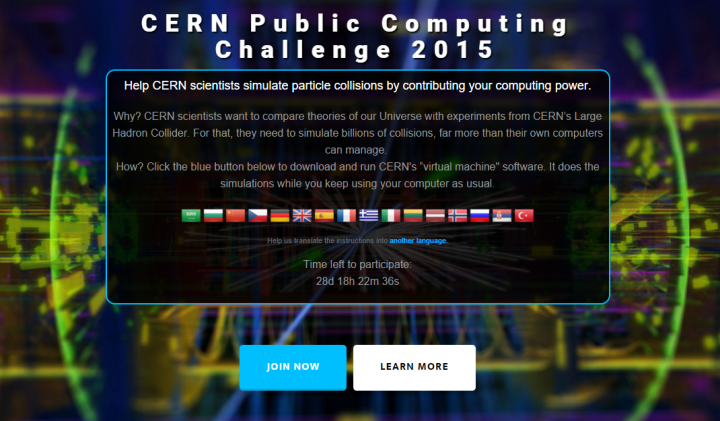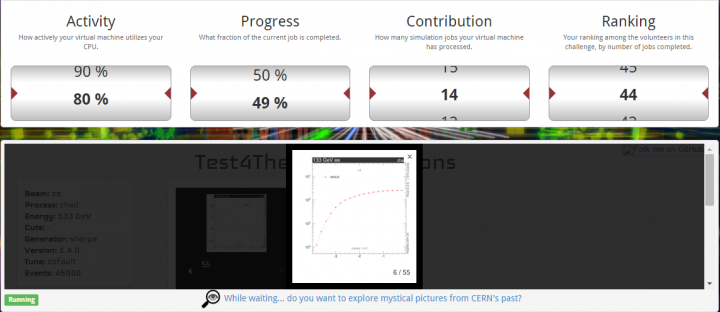Whether you have a passion for physics, general desire to push the boundaries of science, or have no clue about these things at all, but simply think the idea of smashing some particles together is "pretty cool" - we have a proposition for you.

CERN Public Computing Challenge 2015 will run for a month, and aim to involve as much of the general public throughout the world as possible.
CERN Public Computing Challenge 2015 invites everyone with a PC to dedicate their spare computing power to solve actual scientific questions - those being unraveled in the famous Large Hadron Collider(LHC) itself.
I am only one... how can I help?
Believe it or not, most modern computers, including yours, have a lot more computing power that they actually use at a given time. Yet many cutting-edge scientific endeavors (such as, say, unravelling the history of the universe) need loads of such power to run complex algorithms. More than is possible to obtain without (or even with) powerful supercomputers.
That is where volunteer computing comes in. Providing they are connected to the Internet, thousands of otherwise idle computers can be put to work, not just supporting, but enabling scientific research that would otherwise be out of reach.

Gender imbalance is a common issue in volunteer computing - CERN Public Computing Challenge 2015 sets out to change that, and collect as much data as possible about the participation of different sexes, as well as linguistic variety of contributors.
Take LHC for example - in order to improve our knowledge of the universe, theories must be tested and validated. To do that, theoretical particle collisions must be simulated and compared to experimental results, such as those actually observed at the LHC. Volunteers have already carried out billions of such particle simulations through LHC@home projects, pushing our understanding of natural phenomena further with every task completed.

Volunteers are able to see how many particle simulations they have contributed, compete for ranking and digital credits with other participants, visualize data and engage in other games & activities to do with particle physics.
State-of-the-art technology
Innovative computing platforms, such as BOINC, have by now figured out how to plug in thousands of idle computers into a single task with impressive results.
In BOINC, for example, there are currently over 50 volunteer computing projects, including the classics, such SETI@home, which asks to analyze radio telescope data in Search for Extra Terrestrial Intelligence; Folding@home, which is looking for cures for complex diseases, such as Alzheimer's; humanitarian projects, such as Malariacontrol.net, and many others. Since its release in 2002, millions of volunteers have contributed to BOINC projects this way, taking an active role in the progress of science.
However, building a project that could successfully run on any PC can be a tedious task, as they need to be optimized for different operating systems. CERN has figured out a workaround that too - its very own virtual machine technology (CernVM) allows to run a guest operating system on any operating system, therefore science projects packaged into CernVM are compatible with any PC.
Over 12 days of the first CERN computing challenge, which took place as part of CERN’s 60th anniversary celebrations in December 2014, the researchers have achieved astonishing results with the new technology, not to mention gathered enormous amount of data relevant for the LHC experiments.
My computer does all the work... what about me?
While your PC is busy simulating particle collisions, there are active roles for you to play as well. One is engaging with an education game built on the principle of LHC@home - Virtual Atom Smasher. Here you can use your intelligence to fine-tune the infamous machine, while learning particle physics at the same time.

Thanks to the efforts of volunteers, billions of particle collisions were simulated during the last challenge, giving a jump start to Virtual Atom Smasher - a game to learn particle physics, while contributing to real research.
If you have a keen eye, you can help search for exotic particle decays on Higgs Hunters, by classifying images from the ALTAS detector. Or if that is not enough, give your creativity free reign and remix your own particle game through Redwire.io! (And much more).
Challenge extended…
This year, the challenge, organized by the Citizen Cyberscience Centre, will last for a month and be concerned with both physics simulations, and those aiding the humanitarian field as well. Moreover, in the name of involving more of the public in science, wider communities will be targeted in order to achieve better gender balance and linguistic diversity among the participants.
Every week, the participants will have an opportunity to compete for a "Challenge Crunchers" and "Challenge Pioneers" status, by submitting the most tasks and completing the most collision events.
Challenge accepted? Join the CERN Public Computing Challenge 2015 NOW!
Story Source:
The above story is reprinted with permission of Technology.